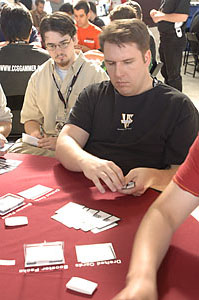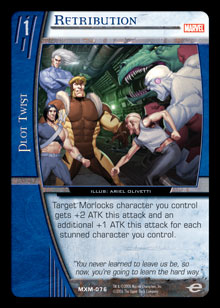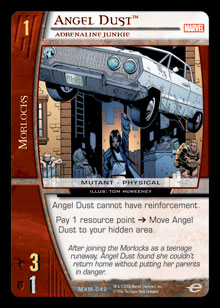
 In this article, I will take a look at the importance of deck synergy in terms of drafted decks using the three X-Men decks that I drafted at Pro Circuit San Francisco. Because Infinite Crisis is the current set being played in Sealed Pack events, you might think that there is little or nothing that you can learn from reading about my final three X-Men drafting experiences. But in truth, the fact that my examples are from X-Men drafts is irrelevant. No matter what the card set, being able to draft a deck with oozing synergy is what wins tournaments. So, look not to this article for specific card-based tips. Instead, please read on in hopes of gaining a better understanding of what deck synergy really is and how it makes all the difference between good and great results.
In this article, I will take a look at the importance of deck synergy in terms of drafted decks using the three X-Men decks that I drafted at Pro Circuit San Francisco. Because Infinite Crisis is the current set being played in Sealed Pack events, you might think that there is little or nothing that you can learn from reading about my final three X-Men drafting experiences. But in truth, the fact that my examples are from X-Men drafts is irrelevant. No matter what the card set, being able to draft a deck with oozing synergy is what wins tournaments. So, look not to this article for specific card-based tips. Instead, please read on in hopes of gaining a better understanding of what deck synergy really is and how it makes all the difference between good and great results.
After a strong 8-2 Day 1 performance with “Ivy League,” I was sitting near the top of the standings in 14th place. Getting off to such a good start was wonderful, but it also presented a difficult challenge; joining me for the first round of drafting were my teammates Karl Horn, Adam Bernstein, and Adam Prosak. Other top pros, such as Mike Dalton and eventual Pro Circuit: San Francisco champion Ian Vincent, were also in my pod. Mastering this table was going to take some very good drafting and playing, and just might require a little luck, too.
I began my draft with Tommy, Runaway, a flexible pick that I would prefer to put into a strong Morlock evasion-themed deck. I tried to stay as open to my options as possible until I could get a clear signal about what was being passed my way. I took a sixth-pick Bum’s Rush to be the “green light” to focus on a Morlock evasion deck. This draft was covered here, so if you are interested, you can get all of the details.
The deck I ended up with was nothing short of a powerhouse. Here is the list.
1-Drops
1 Jubilee, Jubilation Lee
1 Electric Eve, Live Wire
1 Tommy, Runaway
1 Artie, Arthur Maddicks
2-Drops
1 Dazzler, Rock Star
1 Shadowcat, Katya
2 Tar Baby, Adhesive Ally
3-Drops
1 Beast, Feline Geneticist
1 Healer, Life Giver
1 The Beautiful Dreamer, Dreamweaver
1 Caliban, Mutant Bloodhound
4-Drops
1 Hump, Servant of Masque
1 Bishop, XSE Commando
1 Storm, Leader of the Morlocks
5-Drops
1 Cyclops, Blue Leader
2 Polaris, Acolyte
6-Drops
1 Iceman, Deep Freeze
1 Callisto, Morlock Queen
Plot Twists
1 Bum’s Rush
1 Shrapnel Blast
1 Turnabout
2 Retribution
1 The Forsaken, Team-Up
1 Mutopia, Team-Up
1 Good Samaritan
Locations
1 X-Corp: Hong Kong
1 The Alley
If you’re familiar with drafting and playing with the X-Men set, then you probably agree that this deck is just about off the charts. The two copies of Polaris are what keeps this deck somewhere within the stratosphere.
So, how was I able to draft such an incredible deck at a table with so much strong competition? I believe the answer is that I did a great job of reading signals and I also got a little lucky. I look forward to writing more about reading signals in a draft, but for now, I’d like to try to focus just on synergy.
Does this deck ooze with synergy? The answer is yes. In my article analyzing the results of “The Experiment,” I noted that Jason Hager asked, “What is this deck designed to do?” Looking back at these three drafts, I think I was asking this question to myself as I evaluated each of my picks.
 This deck was designed to rule the combat phase, mostly on turns 4, 5, and 6. The objective was to get the most positive effect from evading smaller characters in early turns in order to achieve the big payoff in the middle to late turns. Cards like Retribution, Bum’s Rush, and Shrapnel Blast could be used to their fullest potential with this combination of cards. To help speed the game along, I had numerous small evaders and extra burn from a few of my characters and from The Alley.
This deck was designed to rule the combat phase, mostly on turns 4, 5, and 6. The objective was to get the most positive effect from evading smaller characters in early turns in order to achieve the big payoff in the middle to late turns. Cards like Retribution, Bum’s Rush, and Shrapnel Blast could be used to their fullest potential with this combination of cards. To help speed the game along, I had numerous small evaders and extra burn from a few of my characters and from The Alley.
Why Polaris? First of all, I had to pass on a number of opportunities to snag more ideal 5-drops to ensure that my lower curve and powerful plot twists were plentiful. Because cards like Bum’s Rush and Shrapnel Blast require a critical mass of stunned characters, I had to draft the smaller characters with evasion at a premium. The payoff was, of course, having a deck with layers of synergy. Polaris wasn’t just a flying “vanilla” character, though. The Morlocks characters have a very hard time breaking up formations because none of them have flight. With two copies of Polaris and one copy of Storm, there would still be a chance that Polaris could give all of my characters flight for one critical turn. Also, I ended up playing one copy of Iceman, which would require discarding an Energy card. Since Polaris also met this requirement, she fit the bill quite nicely.
As you might guess, I fared quite well in my first draft. I won all three of my rounds and found myself second seed in the tournament and at the top draft table for my next round. This table was almost as stacked with top Vs. System professionals as the first pod. Karl Horn, Vidianto Wijaya, Kim Caton, and Tim Batow joined me and a few others at this table.
Here are the thirty cards I registered at the end of this draft:
1-Drops
1 Lockheed, Saurian Sidekick
1 Electric Eve, Live Wire
1 Tommy, Runaway
1 Toad, Hopalong
1 Kleinstock Brothers, Acolyte
2-Drops
1 Tar Baby, Adhesive Ally
1 Cannonball, Blast Field
3-Drops
2 Joanna Cargill, Acolyte
1 Healer, Life Giver
1 Caliban, Mutant Bloodhound
4-Drops
1 Bishop, XSE Commando
1 Havok, Critical Mass
1 Hump, Servant of Masque
5-Drops
1 Feral, Maria Callasantos
1 Wolverine, The Best at What He Does
1 Marrow, Gene Nation
6-Drops
2 Callisto, Morlock Queen
Plot Twists
2 Kill or be Killed
2 Turnabout
2 Immovable
2 Neutralized
1 Special Delivery
1 Mutopia, Team-Up
1 Brave New World, Team-Up
The deck I ended up drafting had a ton of upsides but lacked synergy. With six combat-modifying plot twists and two “Finishing Moves,” it looks on the surface as if this deck might be able to hold its own. But against top competition, a deck that fails to gel completely can fall apart at the seams.
Here is the breakdown of this deck’s weaknesses. First of all, this was supposed to be a Physical trait–stamped deck. I managed to scrape fourteen Physical characters together, but I filled the rest of my curve with four Energy characters and one non-Mutant. The two Immovables might still prove their worth, but would fall short of their full potential if I was not able to get those five non-Physical characters to share the Physical trait via the one Brave New World at some point during the game.
If I had been able to draft a few more Physical characters and another copy or two of Mutopia, then my team-stamped plot twists would have been more playable in every situation. Turnabout and Neutralized are both very strong cards, but only if they can be played at almost any given time. This deck had ten Morlock characters, but only five X-Men.
Notice that the character curve is lacking depth in 2-drops also. I played an extra 1-drop, Lockheed, to give me more chances of playing something on both turns 1 and 2. Lockheed also upped the count of X-Men to five, a number that is dangerously low to be playing two Turnabouts with. Unfortunately, Lockheed’s potential upside is lost in a deck with only four characters sharing the Energy trait.
The bottom line is that this deck was far too dependent on its two Team-Ups with four Brotherhood, five X-Men, and ten Morlocks characters and its too few 2-drops. This deck probably could have been saved if three of the 1-drops had instead been about two more 2-drops and one more Brave New World or possibly Mutopia. A Physical deck with oozing synergy would have eighteen to twenty characters all sharing the Physical trait and about three Mutopias enabling me to ignore team stamps and maximize incredible cards like Immovable.
It is difficult to say whether I botched a few of my draft picks or not. It’s tough to admit, but I probably did. With the deck listed above, I knew that I was going to need a little luck to win one or two matches. I had no expectation of winning all three.
At the end of round 16, I felt pretty lucky to have won one of my three matches. I still managed to hang onto seventh seed going into the final draft despite my 1-2 performance. Seated around the table with me were some more of the usual suspects. My teammate Gabe Walls joined me, along with Vidianto Wijaya, Kim Caton, Tim Batow, and Ian Vincent.
During this draft, I picked up on an early signal that X-Men were being under-drafted, as was the Energy archetype. By the end of pack 1, I already had three copies of Iceman, Deep Freeze in my card pool, one of which was a gift given to me thirteenth pick. Have a look below at my favorite deck of the three that I drafted in San Francisco.
1-Drops
1 Pyro, Freedom Force
1 Angel Dust, Adrenaline Junkie
2-Drops
1 Cannonball, Blast Field
2 Shadowcat, Katya
3-Drops
1 Bevatron, Hellion
1 Xorn, Shen Xorn
1 Caliban, Mutant Bloodhound
4-Drops
1 Bishop, XSE Commando
1 Havok, Critical Mass
2 Unuscione, Acolyte
5-Drops
1 Cyclops, Blue Leader
1 Gambit, Ragin’ Cajun
6-Drops
3 Iceman, Deep Freeze
7-Drops
1 Rogue, Anna Marie
1 Fabian Cortez, Acolyte
8-Drops
1 Magneto, Ruler of Avalon
Plot Twists
2 Magnetic Force
1 Drain Essence
2 Super Hero Showdown
2 Mutopia, Team-Up
2 Brave New World, Team-Up
1 Enemy of My Enemy
Going into pack 3, I was constantly repeating to myself the number of characters I needed to draft at each stop in my curve. I opened Enemy of My Enemy and was delighted not only to snag a money rare, but also to pick up a card that would help me cheat on multiple drops. Playing only three characters at the 3-cost slot and two with a cost of 5 was acceptable because I had the Enemy of My Enemy. I would still have preferred to have gotten one more 5-drop, but one that fit this archetype was never passed late enough for me to draft it.
 I would really have loved to have drafted one more 2-drop. I played Angel Dust because she might be able to compete with opposing 2-drops in a pinch. Aside from those few small imperfections, this deck’s character curve was chocked full of very strong characters at each slot who all worked together and shared the Energy theme.
I would really have loved to have drafted one more 2-drop. I played Angel Dust because she might be able to compete with opposing 2-drops in a pinch. Aside from those few small imperfections, this deck’s character curve was chocked full of very strong characters at each slot who all worked together and shared the Energy theme.
Notice that there are not any ATK modifiers in this deck. Notice the 8-drop. Notice the four Team-Ups. This deck was designed to do something. The object of this deck was to last into the later turns, where playing multiple 7-drops and an 8-drop would dominate the match. Every card in this deck played a role in achieving this goal.
I lost a very close game to Ian Vincent in round 17, but I got back on track to win again in round 18. With one round to go, I was back up to seventh seed but needed a win to make the Top 8. I got an easy win in round 19 with a great draw against one of the weaker decks in my pod, and the rest is history. I made a short appearance in the Top 8, then exited quietly when I lost to Gabe.
I couldn’t resist telling a little of my story about how I fought my way into my first Top 8. Trust me, I tried my best to make this article more about Draft deck synergy. I hope that I have come close to hitting my mark of illustrating why a deck needs to be focused on a goal in order to be absolutely great. As always, I hope reading this article has been fun and somewhat educational. I’ll be back in a week or two to (hopefully) entertain and educate once again.